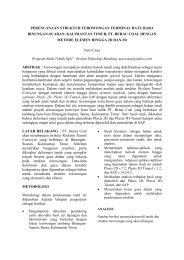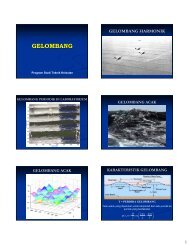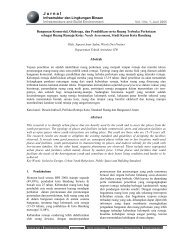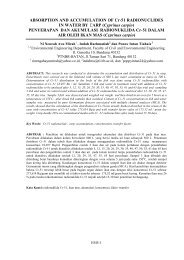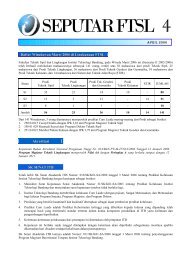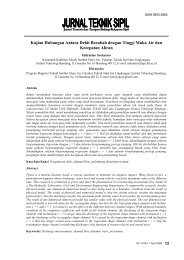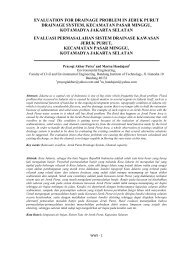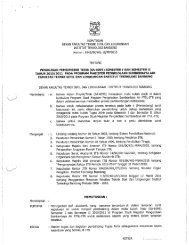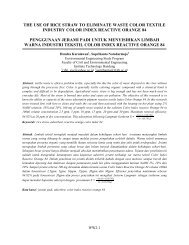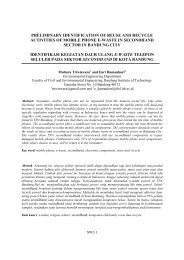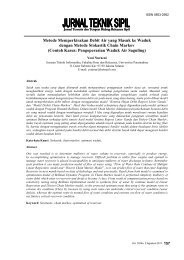PE-SW13-Yudhi Kristian-15305084 - FTSL-ITB
PE-SW13-Yudhi Kristian-15305084 - FTSL-ITB
PE-SW13-Yudhi Kristian-15305084 - FTSL-ITB
Create successful ePaper yourself
Turn your PDF publications into a flip-book with our unique Google optimized e-Paper software.
sampling, fell from 20 cm as 3 times for standard compaction. Measurements made to obtain a<br />
high and weight of garbage. Then identified based on the waste type to be pondered and then<br />
separately in order to obtain the composition of waste. Sitting scales used to measure weight of<br />
the garbage with relatively small and not legible on the spring scale.<br />
Questionnaires were randomly distributed to 40 residents and 2 operators of CWTF.<br />
Meanwhile, the interview is done to 10 people, 2 people, and 2 operators. Questionnaires and<br />
interviews are two approaches that complement each other. The questionnaire is expected to get<br />
the information that has been structured and have a standard objectivity. Meanwhile, the<br />
interview is expected to capture information to a wider and more flexible because the more open<br />
condition in the arrest of a special community.<br />
RESULTS AND DISCUSSION<br />
Communal Waste Treatment Facility<br />
Some of the things that need to be known and discussed for the accuracy and success of the<br />
implementation of CWTF is CWTF Existing conditions, waste characteristics, conditions, and<br />
expectations related to the presence CWTF.<br />
Communal Waste Treatment Facility Sindang Sari built in 2007 by government. CWTF is a<br />
program developed by government in order to support the success of the municipal waste<br />
management. The reason for this preference is CWTF development approach to handling waste<br />
from the source, using the economic value of waste, and involve the community in waste<br />
management. CWTF Sindang Sari built with an area of 210 m2 ± to serve 150 kk who are in the<br />
RT 3 RW 04. CWTF management is done entirely by the community, under the leader of RW<br />
04, Implementing agency handled by karang taruna, with 2-4 people as operators. Financing<br />
operations before CWTF compost product produced entirely depend on the fee from the<br />
community who supported the sale by inorganic waste. The amount of fee is based on the<br />
community level, ranging between Rp 4000, 00 - Rp 10.000, 00. Meanwhile, the government<br />
only serves as the assistant, including the program and control each week or month. CWTF has<br />
as main activities, collectors of household waste, use the type of inorganic waste to be sold, and<br />
the processing of organic waste with the composting. To support the efforts of processing waste<br />
in CWTF, the government share the trash two partitions to each family, each volume has 13 L,<br />
blue for organic waste and yellow for inorganic waste. Garbage collection would be hold using<br />
the garbage cart with two partitions tank with 0.42 m 3 capacity, with dimensions of 1, 25 m x 0,<br />
33 m x 1 m. Garbage collection is scheduled to be done every day for each service block.<br />
However, the management structures that have been planned at the beginning is not in line<br />
with the expected. Karang Taruna who originally appointed the implementing agency is not<br />
prepared because of the lack of human resources who are willing to manage CWTF. Finally,<br />
implementing fully performed by two operators under the direct head of the RW. Plans of CWTF<br />
do garbage collection 2 times in 3 days, one rest day is used to resemble inorganic for separating<br />
waste results in CWTF. Waste separating in CWTF forced to do because almost most of the<br />
people do not separate in one month after the first. Garbage cart with two partitions are<br />
eventually not work well so that garbage collection is in fixed. Composting can not be run to<br />
process organic waste due to equipment problems that do not in function well after the trials.<br />
Levy payment is directly managed by the operators without going through the implementing<br />
agency, as was originally planned. The amount of levy in the range of Rp 2000,00-Rp 10.000,00.<br />
At July 2009, operators set to increase the levy, so some citizenz request to stop service to stop<br />
SW 13-4



